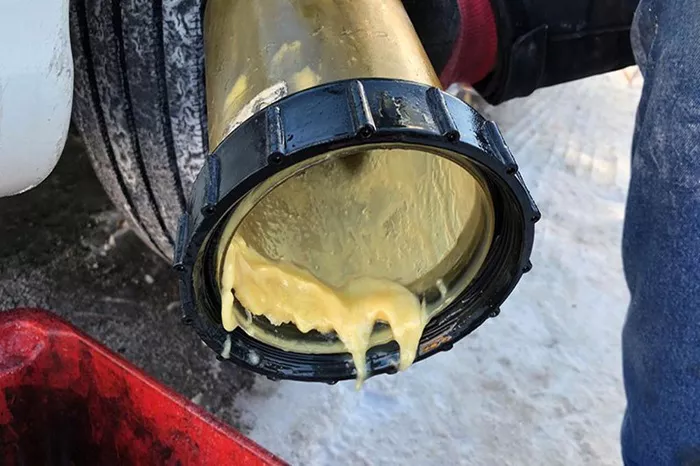Diesel fuel is an essential component in many industries and is used extensively in transportation, construction, and other sectors that rely on heavy machinery. One critical aspect of diesel fuel usage is its susceptibility to gelling, a condition that can render engines inoperable during cold weather. Understanding the temperature at which diesel fuel gels and the factors influencing this phenomenon is crucial for anyone working with diesel engines. This article delves into the mechanics of diesel fuel gelling, the science behind it, the factors affecting the gelling point, and strategies to prevent and mitigate its effects.
Understanding Diesel Fuel Gelling
Diesel fuel gelling, often called “waxing,” occurs when the paraffin wax within the fuel solidifies under cold conditions. Unlike gasoline, diesel fuel contains wax, which is beneficial for its energy content but can pose problems at low temperatures.
Composition of Diesel Fuel
Hydrocarbons: Diesel is primarily composed of hydrocarbons, including alkanes, cycloalkanes, and aromatic hydrocarbons.
Paraffin Wax: A significant component in diesel, paraffin wax provides high energy content but becomes problematic as temperatures drop.
Mechanics of Gelling
Formation of Crystals: As the temperature decreases, the wax in the fuel begins to crystallize. Initially, this process forms small crystals that are suspended in the liquid fuel.
Aggregation of Crystals: As the temperature continues to drop, these crystals grow and start to aggregate, forming larger masses.
Clogging: Eventually, the wax crystals become large enough to clog the fuel filters and lines, preventing fuel from reaching the engine.
Cold Filter Plugging Point (CFPP)
Definition: The CFPP is the lowest temperature at which diesel fuel will still flow through a standardized filter in a specified time.
Importance: This parameter is crucial for determining the operability of diesel engines in cold climates.
Factors Influencing the Gelling Point
The temperature at which diesel fuel gels is not a fixed value and can vary based on several factors, including the composition of the fuel and the presence of additives.
Type of Diesel Fuel
No. 1 Diesel: Also known as winter diesel or Arctic diesel, it has a lower gelling point due to fewer paraffin waxes.
No. 2 Diesel: More common and has a higher energy content, but it gels at higher temperatures than No. 1 diesel.
Additives and Blending
Anti-Gel Additives: These additives are designed to lower the pour point and CFPP of diesel fuel, thus preventing gelling.
Blending with Kerosene: Mixing diesel with kerosene can also lower the gelling point, as kerosene has a lower wax content.
Environmental Factors
Temperature: Naturally, the ambient temperature plays a significant role in the gelling of diesel fuel.
Humidity: Although less impactful than temperature, humidity can affect the gelling process as it might influence the condensation within fuel tanks.
The Impact of Gelling on Diesel Engines
When diesel fuel gels, it can have severe implications for the operability of diesel-powered engines and machinery.
Clogging of Fuel Lines and Filters
Fuel Line Blockage: Wax crystals can block the fuel lines, preventing fuel from reaching the engine.
Filter Clogging: Fuel filters are particularly susceptible to clogging by wax crystals, stopping fuel flow.
Engine Performance
Start-up Issues: Gelled fuel can prevent engines from starting, especially in cold weather conditions.
Reduced Efficiency: Even if the engine starts, the restricted fuel flow can lead to reduced performance and efficiency.
Maintenance and Repair Costs
Increased Maintenance: Engines exposed to gelled diesel may require more frequent maintenance and filter replacements.
Potential Damage: Severe cases of gelling can cause damage to fuel pumps and injectors, leading to costly repairs.
See also: Will Diesel Fuel Evaporate? [Revealed]
Preventing Diesel Fuel Gelling
Prevention is the best approach to dealing with diesel fuel gelling. Several strategies can be employed to ensure that diesel engines remain operational even in cold weather.
Use of Anti-Gel Additives
Selection of Additives: Numerous anti-gel additives are available in the market, each formulated to lower the pour point and CFPP of diesel fuel.
Regular Application: Additives should be used regularly, especially before the onset of cold weather, to ensure the fuel remains fluid.
Winterization of Diesel Fuel
Blending with Winter Diesel: Mixing No. 2 diesel with No. 1 diesel or kerosene can effectively lower the gelling point.
Bulk Storage Considerations: Fuel stored in bulk should be winterized to prevent gelling in storage tanks.
Engine and Fuel System Maintenance
Regular Inspection: Regular inspection of fuel lines and filters can help identify and address potential gelling issues before they become severe.
Heating Systems: Installing fuel line and tank heaters can prevent the fuel from reaching temperatures at which gelling occurs.
Mitigating the Effects of Gelled Diesel
Despite preventive measures, there may be instances where diesel fuel gels. In such cases, knowing how to mitigate the effects is crucial.
Thawing Techniques
Engine Block Heaters: These devices can help warm the engine and fuel system, allowing the wax crystals to melt and fuel to flow again.
Warm Environments: Moving the vehicle or machinery to a warmer environment can help thaw gelled diesel.
Emergency Additives
Emergency Fluidizers: Certain additives are specifically designed to dissolve wax crystals in gelled fuel, restoring flow.
Application Method: These additives should be added directly to the fuel tank and allowed time to work.
Fuel Filter Changes
Filter Replacement: In cases where filters are clogged with wax, replacing them is necessary to restore fuel flow.
Frequent Monitoring: During cold spells, frequent monitoring and changing of filters may be necessary.
Conclusion
Diesel fuel gelling is a significant concern for anyone operating diesel-powered engines in cold weather. Understanding the factors that influence the gelling point, the impacts of gelled fuel, and the methods to prevent and mitigate gelling are essential for maintaining engine operability and efficiency. By employing the right strategies, such as using anti-gel additives, winterizing fuel, and regular maintenance, operators can ensure their diesel engines remain functional even in the harshest of climates.
Related topic:

